宾语从句及动词不定式讲解
宾语从句及动词不定式讲解
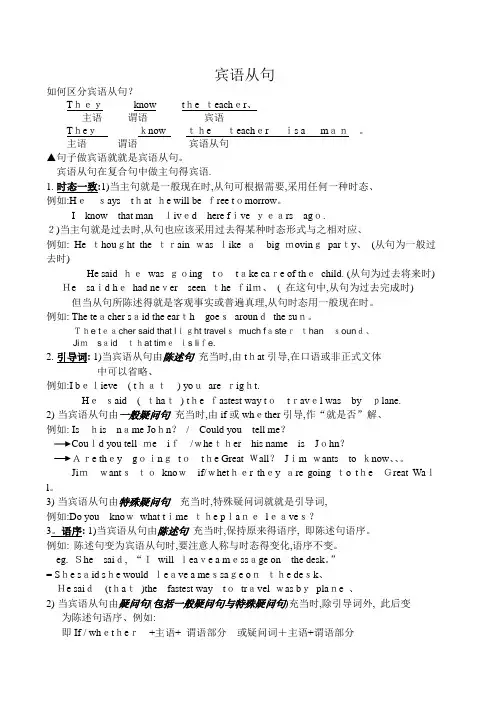
宾语从句如何区分宾语从句?Theyknow the teacher、主语谓语宾语Theyknow the teacher is a man。
主语谓语宾语从句▲句子做宾语就就是宾语从句。
宾语从句在复合句中做主句得宾语.1.时态一致:1)当主句就是一般现在时,从句可根据需要,采用任何一种时态、例如:Hesays that he will be free tomorrow。
I know that manlived here five years ago.2)当主句就是过去时,从句也应该采用过去得某种时态形式与之相对应、例如: He thought the train was like abig movingparty、(从句为一般过去时)He said hewas going totake care of thechild. (从句为过去将来时) He said hehad never seen the film、( 在这句中,从句为过去完成时) 但当从句所陈述得就是客观事实或普遍真理,从句时态用一般现在时。
例如: The teacher said the earth goesaroundthe sun。
The teacher said that light travelsmuch fasterthansound、Jimsaidthat timeis life.2.引导词: 1)当宾语从句由陈述句充当时,由that引导,在口语或非正式文体中可以省略、例如:I believe( that) youare right.Hesaid( that) the fastest way totravel was byplane.2)当宾语从句由一般疑问句充当时,由if或whether引导,作“就是否”解、例如: Ishis name John?/Could you tell me?Could you tell me if/whether his name is John?Are they goingtothe Great Wall?Jim wants to know、、。
宾语从句结构及用法
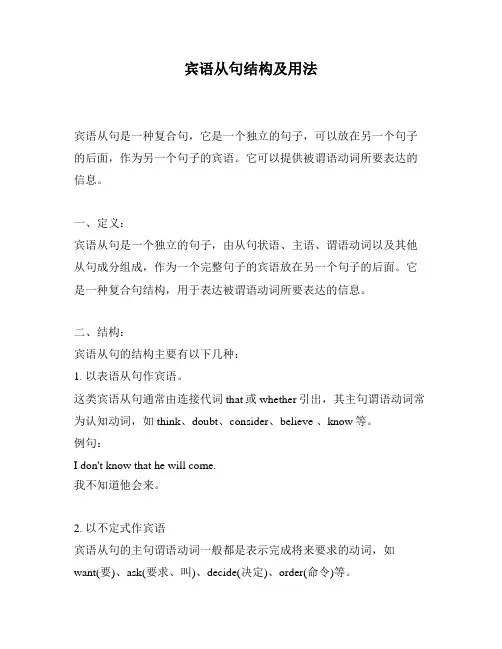
宾语从句结构及用法宾语从句是一种复合句,它是一个独立的句子,可以放在另一个句子的后面,作为另一个句子的宾语。
它可以提供被谓语动词所要表达的信息。
一、定义:宾语从句是一个独立的句子,由从句状语、主语、谓语动词以及其他从句成分组成,作为一个完整句子的宾语放在另一个句子的后面。
它是一种复合句结构,用于表达被谓语动词所要表达的信息。
二、结构:宾语从句的结构主要有以下几种:1. 以表语从句作宾语。
这类宾语从句通常由连接代词that或whether引出,其主句谓语动词常为认知动词,如think、doubt、consider、believe 、know等。
例句:I don't know that he will come.我不知道他会来。
2. 以不定式作宾语宾语从句的主句谓语动词一般都是表示完成将来要求的动词,如want(要)、ask(要求、叫)、decide(决定)、order(命令)等。
例句:He asked me to go there.他要求我去那儿。
3. 以动词不定式短语作宾语宾语从句的谓语动词一般是表示给予反馈的动词,如tell(告诉)、explain(解释)、show(显示)等。
例句:My teacher explained to us how to solve the problem.我的老师解释给我们如何解决这个问题。
4. 由从属连词who、which、that、whom等引导的宾语从句宾语从句的谓语动词常为行为动词,如see(看见)、hear(听见)、make(使)、find(发现)等。
例句:I heard that he was ill.我听说他病了。
三、用法:1、在宾语从句中,无论是什么类型的宾语从句,都应该将主句和宾语从句中的谓语动词时态保持一致。
2、介词后面也可以接宾语从句,主句的谓语动词一定是表示把某人或某物带到某处的意思的动词。
3、宾语从句紧跟在主句之后,而且:如果主句放在宾语从句之前,宾语从句中的从属连词要和主句已经具体指定的主语或宾语相一致。
初中九年级英语动词不定式和宾语从句语法详解
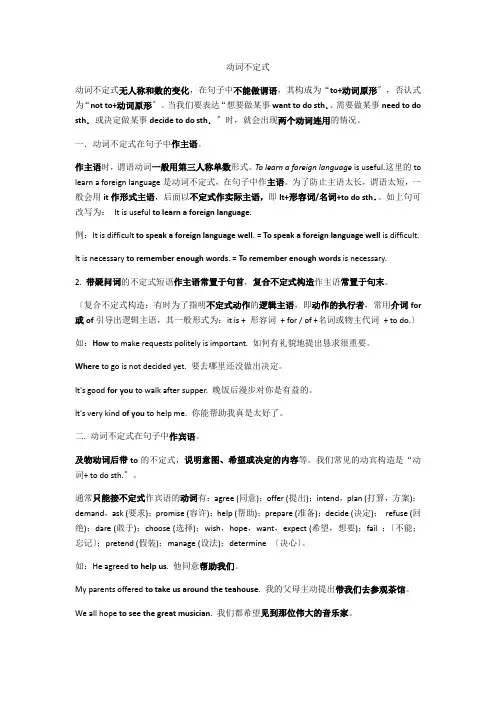
动词不定式动词不定式无人称和数的变化,在句子中不能做谓语,其构成为“to+动词原形〞,否认式为“not to+动词原形〞。
当我们要表达“想要做某事want to do sth.、需要做某事need to do sth.或决定做某事decide to do sth.〞时,就会出现两个动词连用的情况。
一.动词不定式在句子中作主语。
作主语时,谓语动词一般用第三人称单数形式。
To learn a foreign language is useful.这里的to learn a foreign language是动词不定式,在句子中作主语。
为了防止主语太长,谓语太短,一般会用it作形式主语,后面以不定式作实际主语,即It+形容词/名词+to do sth.。
如上句可改写为:It is useful to learn a foreign language.例:It is difficult to speak a foreign language well. = To speak a foreign language well is difficult.It is necessary to remember enough words. = To remember enough words is necessary.2. 带疑问词的不定式短语作主语常置于句首,复合不定式构造作主语常置于句末。
〔复合不定式构造:有时为了指明不定式动作的逻辑主语,即动作的执行者,常用介词for 或of引导出逻辑主语,其一般形式为:it is + 形容词+ for / of +名词或物主代词+ to do.〕如:How to make requests politely is important. 如何有礼貌地提出恳求很重要。
Where to go is not decided yet. 要去哪里还没做出决定。
It's good for you to walk after supper. 晚饭后漫步对你是有益的。
宾语从句讲解
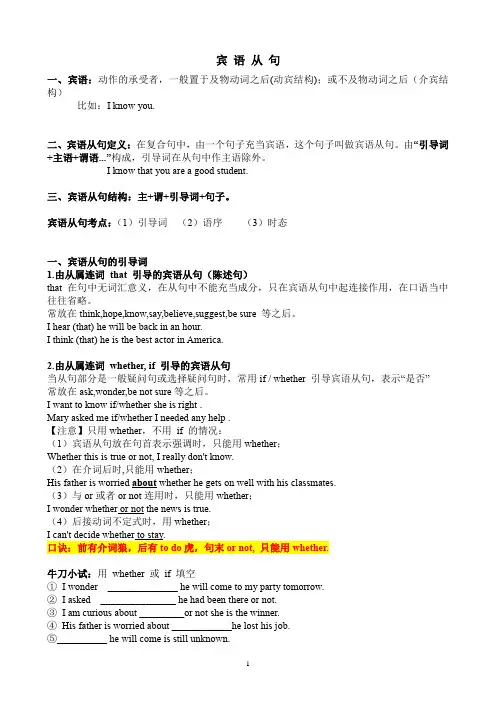
宾语从句一、宾语:动作的承受者,一般置于及物动词之后(动宾结构);或不及物动词之后(介宾结构)比如:I know you.二、宾语从句定义:在复合句中,由一个句子充当宾语,这个句子叫做宾语从句。
由“引导词+主语+谓语...”构成,引导词在从句中作主语除外。
I know that you are a good student.三、宾语从句结构:主+谓+引导词+句子。
宾语从句考点:(1)引导词(2)语序(3)时态一、宾语从句的引导词1.由从属连词that 引导的宾语从句(陈述句)that 在句中无词汇意义,在从句中不能充当成分,只在宾语从句中起连接作用,在口语当中往往省略。
常放在think,hope,know,say,believe,suggest,be sure 等之后。
I hear (that) he will be back in an hour.I think (that) he is the best actor in America.2.由从属连词whether, if 引导的宾语从句当从句部分是一般疑问句或选择疑问句时,常用if / whether 引导宾语从句,表示“是否”常放在ask,wonder,be not sure等之后。
I want to know if/whether she is right .Mary asked me if/whether I needed any help .【注意】只用whether,不用if 的情况:(1)宾语从句放在句首表示强调时,只能用whether;Whether this is true or not, I really don't know.(2)在介词后时,只能用whether;His father is worried about whether he gets on well with his classmates.(3)与or或者or not连用时,只能用whether;I wonder whether or not the news is true.(4)后接动词不定式时,用whether;I can't decide whether to stay.口诀:前有介词狼,后有to do虎,句末or not, 只能用whether.牛刀小试:用whether 或if 填空①I wonder ______________ he will come to my party tomorrow.②I asked _______________ he had been there or not.③I am curious about _________or not she is the winner.④His father is worried about ____________he lost his job.⑤__________ he will come is still unknown.⑥I am not sure _________ to go out tonight.参考答案:①if/whether ②whether ③whether ④whether ⑤whether ⑥whether3.由连接代词Who,whom,whose,which,what 和连接副词where, how, why, when 引导的宾语从句,不可省略。
宾语从句及动词不定式讲解教学提纲
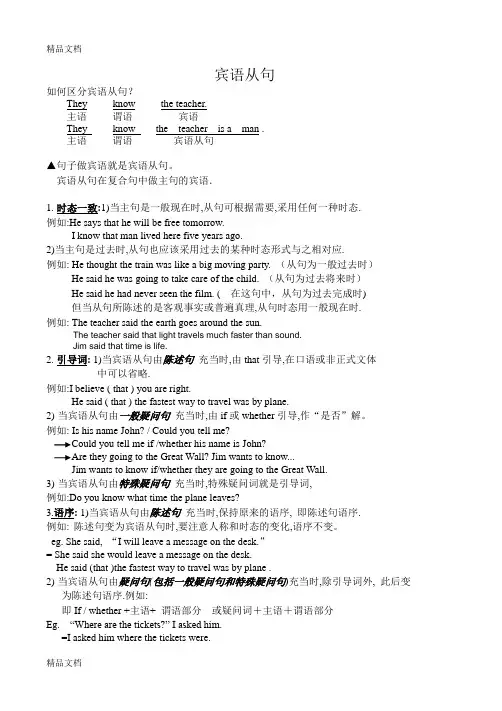
宾语从句如何区分宾语从句?They know the teacher.主语谓语宾语They know the teacher is a man .主语谓语宾语从句▲句子做宾语就是宾语从句。
宾语从句在复合句中做主句的宾语.1.时态一致:1)当主句是一般现在时,从句可根据需要,采用任何一种时态.例如:He says that he will be free tomorrow.I know that man lived here five years ago.2)当主句是过去时,从句也应该采用过去的某种时态形式与之相对应.例如: He thought the train was like a big moving party. (从句为一般过去时)He said he was going to take care of the child. (从句为过去将来时)He said he had never seen the film. (在这句中,从句为过去完成时)但当从句所陈述的是客观事实或普遍真理,从句时态用一般现在时.例如: The teacher said the earth goes around the sun.The teacher said that light travels much faster than sound.Jim said that time is life.2.引导词: 1)当宾语从句由陈述句充当时,由that引导,在口语或非正式文体中可以省略.例如:I believe ( that ) you are right.He said ( that ) the fastest way to travel was by plane.2)当宾语从句由一般疑问句充当时,由if或whether引导,作“是否”解。
例如: Is his name John? / Could you tell me?Could you tell me if /whether his name is John?Are they going to the Great Wall? Jim wants to know...Jim wants to know if/whether they are going to the Great Wall.3)当宾语从句由特殊疑问句充当时,特殊疑问词就是引导词,例如:Do you know what time the plane leaves?3.语序: 1)当宾语从句由陈述句充当时,保持原来的语序, 即陈述句语序.例如:陈述句变为宾语从句时,要注意人称和时态的变化,语序不变。
宾语从句的含义
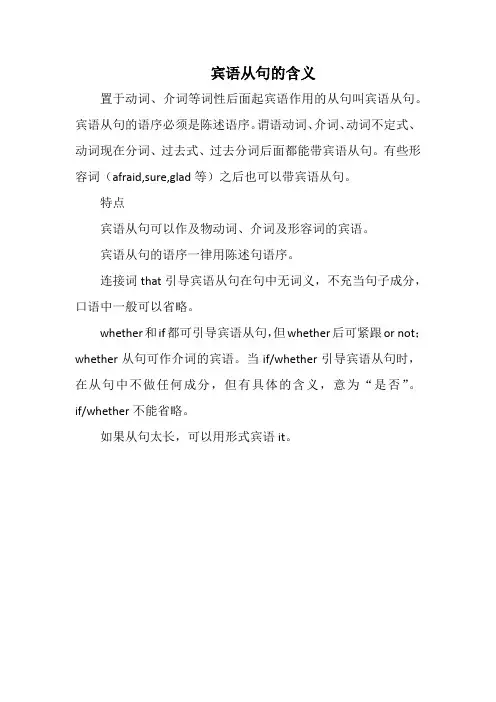
宾语从句的含义
置于动词、介词等词性后面起宾语作用的从句叫宾语从句。
宾语从句的语序必须是陈述语序。
谓语动词、介词、动词不定式、动词现在分词、过去式、过去分词后面都能带宾语从句。
有些形容词(afraid,sure,glad等)之后也可以带宾语从句。
特点
宾语从句可以作及物动词、介词及形容词的宾语。
宾语从句的语序一律用陈述句语序。
连接词that引导宾语从句在句中无词义,不充当句子成分,口语中一般可以省略。
whether和if都可引导宾语从句,但whether后可紧跟or not;whether从句可作介词的宾语。
当if/whether引导宾语从句时,在从句中不做任何成分,但有具体的含义,意为“是否”。
if/whether不能省略。
如果从句太长,可以用形式宾语it。
英语句子成分讲宾语从句讲解
句子成分及基本句型一、考点、热点回顾【句子的成分】在英文中句子成分包括:主语、谓语、宾语(直接宾语、间接宾语)、表语、定语和状语、宾语补足语等。
(一)主语:主语是谓语讲述的对象,表示所说的“是什么”或“是谁”。
一般由名词、代词、不定式或相当于名词的词或短语来充当。
它在句首。
如:(1)Lucyisabeautifulnurse.(名词作主语)(2)Hereadsnewspaperseveryday.(代词作主语)(3)Smokingisharmfultothehealth.(动名词作主语)(4)ToswiminKunmingLakeisagreatpleasure.(不定式作主语)(5)Whatweshoulddoisnotyetdecided.(主语从句作主语)(二)谓语说明主语“做什么”“是什么”或“怎么样”谓语和主语在人称和数两方面必须一致。
它在主语后面。
如:Hisparentsareteachers.(系动词和表语一起作谓语)Westudyhard.(行为动词作谓语)Wedon’tfinishreadingthebook.(助动词和行为动词一起作谓语)HecanspeakEnglish.(情态动词和行为动词一起作谓语)(三)宾语宾语是动作、行为的对象,由名词、代词、不定式或相当于名词的词、短语来担任,它和及物动词一起说明主语做什么。
一般放在谓语之后。
Sheisdoingherhomeworknow.(名词作宾语)Shesays(that)sheisill.(宾语从句作动词宾语)Weoftenhelphim.(代词作宾语)Helikestoplaybasketball.(不定式作宾语)Weenjoylisteningtothemusic.我们喜欢听音乐。
(动名词短语作宾语)说明1:宾语是及物动词涉及到的人或物,宾语一般放在及物动词之后。
介词后面的名词或代词或动名词,称为介词宾语。
名词、代词、数词常在句中做动词宾语或介词宾语。
宾语从句用法全解以及应注意要点(精华)
英语中的连接代词有:who,whom,whose,which,what,在句中担任主语、宾语、定语或者表语。
例句:Can you tell me whom you are waiting for?
英语中的连接副词有:when,where,why,how,在句中担任状语的成分。
例句:None of us knows where these new parts can be bought.
当主句的谓语动词与that宾语从句之间有插入语时,that一般不可省。
例句:Just then I noticed, for the first time, that our master was wearing his fine green coat and his black silk cap.
当宾语从句表示的是一个客观真理或者事实时,即使主句是过去时,从句也用一般现在时态。
例句:The teacher told his class that light travels faster than sound.
五.宾语从句的特点宾语从句可以作及物动词、介词及形容词的宾语。
宾语从句的语序一律用陈述句语序。
连词:that (that 常可省略),whether, if
代词:who, whose, what ,which
副词:when ,where, how, why 等。
(一)that引导的宾语从句(在非正式场合that可以省略)
可跟that从句做宾语的动词有:
say, think, insist, wish, hope, demand, imagine, wonder, know, suppose, see, believe, agree, admit, deny, expect, explain, order, command, feel, dream, suggest, hear, mean, notice, prefer, request, require, propose, declare, report等。
宾语从句知识点讲解总结
宾语从句知识点讲解总结宾语从句的结构:宾语从句一般由连接词引导,连接词可以是关系代词、关系副词或从属连词。
例如:I know (that) she is coming. (我知道她要来了)- 这里的 that 就是一个引导宾语从句的从属连词。
I heard what you said.(我听到你说的话)- 这里的 what 就是一个引导宾语从句的关系代词。
I don't know when he will come.(我不知道他什么时候会来)- 这里的 when 就是一个引导宾语从句的关系副词。
宾语从句的使用:1. 宾语从句可以出现在主句的动词后面,作动词的宾语。
例如:I know (that) she is coming.(我知道她要来了)。
2. 宾语从句也可以出现在主句的介词后面,作介词的宾语。
例如:I am interested in what you said.(我对你说的话感兴趣)。
3. 宾语从句还可以出现在主句的及物动词之后,作宾语。
例如:I heard what you said.(我听到你说的话)。
下面我们将从名词从句和主语从句两个方面对宾语从句进行详细的讲解。
一、名词从句名词从句主要由 that, whether, what, whatever, which, who, whom, whose, when, where, why, how 等词引导。
名词从句作宾语时可以放在及物动词或者介词之后。
名词从句作宾语时,要根据引导词后面的动词的性质来选择合适的连接词。
以下是一些常用的连接词以及它们的用法。
1. thatthat 通常用作连接词,引导宾语从句,连接宾语从句与主句之间。
但在口语和非正式文体中,往往可以省略,但在正式的书面语中不可以省略。
例如:I don't know if he is coming.(我不知道他是否会来。
)I am sure that she is telling the truth.(我确信她在说实话。
宾语从句的用法大全
一.宾语从句的定义之阿布丰王创作置于动词、介词等词性后面起宾语作用的从句叫宾语从句。
宾语从句的语序必须是陈述语序。
谓语动词、介词、动词不定式,v.-ing形式后面都能带宾语从句。
有些形容词(afraid,sure,glad 等)之后也可以带宾语从句。
二.宾语从句中引导词的用法在复合句中作主句的宾语,引导词有:连词:that (that 常可省略),whether, if代词:who, whose, what ,which副词:when ,where, how, why 等。
(一)that引导的宾语从句(在非正式场合that可以省略)可跟that从句做宾语的动词有:say, think, insist, wish, hope, demand, imagine, wonder, know, suppose, see, believe, agree, admit, deny, expect, explain, order, command, feel, dream, suggest, hear, mean, notice, prefer, request, require, propose, declare, report 等。
例句:The boy believes that he will travel through space to other planets.注意事项:当主句谓语动词是 think, believe, suppose, expect 等词,而宾语从句的意思是否定时,常把否定转移至主句暗示。
例句:I don’t think it is right for him to treat you like that.在以下情况中that不克不及省略1.当句中的动词后接多于两个由that引导的宾语从句时,第一个that可省,但后面的that不成省。
例句:He said (that) you were too young to understand the matter and that he was asked not to tell you.2.当主句的谓语动词与that宾语从句之间有拔出语时,that一般不成省。
- 1、下载文档前请自行甄别文档内容的完整性,平台不提供额外的编辑、内容补充、找答案等附加服务。
- 2、"仅部分预览"的文档,不可在线预览部分如存在完整性等问题,可反馈申请退款(可完整预览的文档不适用该条件!)。
- 3、如文档侵犯您的权益,请联系客服反馈,我们会尽快为您处理(人工客服工作时间:9:00-18:30)。
宾语从句如何区分宾语从句?They know the teacher.主语谓语宾语They know the teacher is a man .主语谓语宾语从句▲句子做宾语就是宾语从句。
宾语从句在复合句中做主句的宾语.1.时态一致:1)当主句是一般现在时,从句可根据需要,采用任何一种时态.例如:He says that he will be free tomorrow.I know that man lived here five years ago.2)当主句是过去时,从句也应该采用过去的某种时态形式与之相对应.例如: He thought the train was like a big moving party. (从句为一般过去时)He said he was going to take care of the child. (从句为过去将来时)He said he had never seen the film. (在这句中,从句为过去完成时)但当从句所陈述的是客观事实或普遍真理,从句时态用一般现在时.例如: The teacher said the earth goes around the sun.The teacher said that light travels much faster than sound.Jim said that time is life.2.引导词: 1)当宾语从句由陈述句充当时,由that引导,在口语或非正式文体中可以省略.例如:I believe ( that ) you are right.He said ( that ) the fastest way to travel was by plane.2)当宾语从句由一般疑问句充当时,由if或whether引导,作“是否”解。
例如: Is his name John? / Could you tell me?Could you tell me if /whether his name is John?Are they going to the Great Wall? Jim wants to know...Jim wants to know if/whether they are going to the Great Wall.3)当宾语从句由特殊疑问句充当时,特殊疑问词就是引导词,例如:Do you know what time the plane leaves?3.语序: 1)当宾语从句由陈述句充当时,保持原来的语序, 即陈述句语序.例如:陈述句变为宾语从句时,要注意人称和时态的变化,语序不变。
eg. She said, “I will leave a message on the desk.”= She said she would leave a message on the desk.He said (that )the fastest way to travel was by plane .2)当宾语从句由疑问句(包括一般疑问句和特殊疑问句)充当时,除引导词外, 此后变为陈述句语序.例如:即If / whether +主语+ 谓语部分或疑问词+主语+谓语部分Eg. “Where are the tickets?” I asked him.=I asked him where the tickets were.I don’t know if/whether he could answer the question.Please tell me who(whom) I will meet tomorrow.4.宾语从句和状语从句的区分:eg. 1) I will go out tomorrow if it is fine tomorrow.2) I don’t know if the train has arrived.句1中if引导的是状语从句。
这个从句表示“条件”,整个句子的意思是如果明天天气好,我就出去。
句2中if引导的是宾语从句,充当谓语动词don’t know的宾语。
整个句子的意思是我不知道火车是否已到达。
判断方法:1、可以从整个句式看。
状语从句一般可以放在主句的前面或后面(个别除外),宾语从句只能放在主句谓语动词之后。
2、从引导词看。
if充当宾语从句的连接词时,相当于whether,词义为“是否”,充当状语从句的连接词时,词义为“如果”。
when充当宾语从句的连接词时,意为“什么时候”,充当状语从句的连接词时,意为“当……的时候”( ) We're not sure if it _______ tomorrow.If it _______,we won't climb the South Hill.(2004年青海西宁)A.will snow;snowsB.will snow;will snowC.snows;snowsD.snows;will snow5. 宾语从句在一定条件下,可以简化为“特殊疑问词+不定式”、“it +形容词+不定式短语”1)I don't know what I should do with the letter.(改为简单句)(2005年山东烟台)I don't know what __________ _________ with the letter.2)Can you tell me how to get to the nearest hospital? (改为宾语从句)Can you tell me how _______ ______ ________ _____ the nearest hospital?3)I think it is very important to study English well.I think _______ ________ to study English well.宾语从句习题()1.Could you tell me ________?A if he would come tomorrowB will he come tomorrowC whether he will come tomorrowD If he comes tomorrow()2.Could you tell me ___________________?A where is the part ?B who’s on duty ?C whose book is this ?D what are they doing ?()3. I want to know ___________.A. which house does your sister liveB. which houses does his uncle live inC. which house his uncle livesD. which house his uncle lives in()4. Father told us that they _____ on a field trip.A. will goB. are goingC. have goneD. were going()5. I want to know ________.A. who is he waitingB. who is he waiting forC. who he is waitingD. who he is waiting for()6. Can you tell me ________?A. where she is goingB. where she goingC. where is she goingD. where is she going to()7. Do you know ___________ this time yesterday?A.what she is cookingB.what is she cookingC.what she was cookingD.what was she cooking()8. Do you know how much hot water_______?A.Mum is needed B.does Mum need C.Mum needs D.did Mum need ( )9. Can you tell me_______?A.where he is B.where is he C.he is where D.what is he( )10. I didn't know how _______ to London?A.would they go B.are they going C.they would go D.they are going ( )11.Let me tell you __________________.A. how much is the carB. how much does the car costC. how much did I pay for the carD. how much I spent on the car ( )12.Do you know _______?A.what the news are B.what is the newsC.what the news is D.what are the news( )13.He said he would help me with my maths if he _______ free.A.was B.will be C.would be D.is( )14.I don't know if she ______ .If she ______ ,please let me know.A.comes;comes B.will come;will comeC.comes;will come D.will come;come( )15. Peter knew _______________.A. whether he has finished reading the bookB. why the boy had so many questionsC. there were 12 months in a yearD. when they will leave for Paris( )16.I didn't know what ______ .A.was the matter B.is the matter C.matter was D.the matter is ( )17.I couldn't agree with ______ at the meeting.A.that you said B.which you saidC.what did you say D.what you said( )18.My friend asked me ______ .A.that who is girl B.who that girl wasC.who was that girl D.that girl was who(( )20.My teacher asked me ______ .A.who dictionary this was B.whose dictionary this wasC.whose dictionary was this D.who dictionary was this动词不定式用法动词不定式的基本形式是“to+动词原形”,有时可以不带to。
